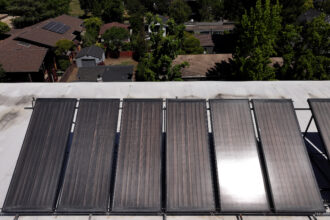Athens—Tasos Dimalexis and his colleagues from the Hellenic Ornithological Society had spent days scouring the rocky promontory on the remote Greek island of Tilos.
They were seeking a suitable site for a 55-meter high wind turbine—one that would be least likely to disturb several pairs of rare Bonelli’s eagles that nest there every spring.
“We did a lot of scrambling on the cliffs to find a place for the platform,” he says. “But it worked out . . . The birds are still coming back!”
The brown-and-white eagles became regular visitors after Tilos banned hunting in the late 1980s, the first Aegean island to do so. Inspired, the residents took a collective decision to transform the island into a “green” conservation zone for plants and wildlife.
Tilos is now the first island in southern Europe to build a hybrid power station with battery storage, which could become an example for other isolated communities looking to go green. Islands have long been centers of experimentation for new energy technologies, because they usually lack fossil fuel resources. The Orkney Islands off Scotland are powered by wind and tidal energy, while the nation of Fiji is building the largest solar farm in the Pacific Islands.
Dimalexis, a nature conservation consultant, was asked to find the turbine site as part of a €15 million (about $18 million) clean energy project for Tilos, developed by engineers at the University of West Attica in Psachna, Greece, (UNIWA) with funding from the EU.
The turbine, which was installed in 2017, now produces about three- quarters of the island’s energy in summer and a surplus in the winter months. The UNIWA team has also built a free charging station for hybrid vehicles.
Tilos appears on the map of the Aegean Islands as one of three small blobs between the popular tourist destinations of Kos and Rhodes. Its 500-odd permanent inhabitants make a living from fishing and raising goats. The population swells to around 800 in summer with the arrival of seasonal workers, tourists and expatriate Tiliot families from Rhodes and Athens.
An undersea cable connects Tilos and its neighbouring islands with a diesel-fired power plant on Kos, but outages are frequent in stormy weather. Whenever the cable was seriously damaged, the state power company PPC would send a technician to manually start up the island’s elderly diesel power plant.
Maria Kamma-Aliferi, the mayor of Tilos, says the hybrid power plant has “significantly improved” the quality of life on the island, though outages still occur in summer. “Power cuts were a constant frustration. We’d be without television and hot water, and all the electronics would shut down. The tourists didn’t often complain but it’s embarrassing for a Greek island in the 21st century to be without power,” she said.
The “hybrid” plant generates electricity both from the wind turbine and a small-scale solar panel unit installed in a valley nearby. Surplus power is stored in two high-energy density batteries, each housed in a 20-foot shipping container. A microgrid controls the power supply to around 100 households on the island.
The Tilos municipality receives a 3 percent share of revenues from the power station—operated by Eunice Energy Group, a private Greek company—which sells its electricity production to state energy company PPC.
Setting the Pace for Remote Islands in the Aegean
The clean energy project has opened up new prospects for Tilos, Kamma-Aliferi claims. The permanent population increased by one-fifth between 2001 and 2010 during a boom in Greece that saw ferry links improve and Wi-Fi services reaching remote islands. To her surprise, it remained stable during the long drawn-out economic crisis that followed. “A few island families left while about 50 foreigners, mostly Germans and British, acquired homes here. They live on Tilos for much of the year,” she says.
Kamma-Aliferi wants Tilos to set the pace for the greening of a dozen remote islands in the Aegean. Her most ambitious idea is for the island to lease an electric-powered ferry to replace the diesel-fuelled vessel that links Tilos with Rhodes, a two-and-a-half hour journey in good weather.
On the tiny island Agios Efstratios in the north Aegean—an even smaller island than Tilos with a population of 250—residents are eagerly waiting for construction to start on a hybrid power project similar to Tilos’. If all goes well Terna Energy, a subsidiary of Greece’s largest construction company, will begin the work this year with €6 million (about $7.2 million) in EU funding.
An “off-grid” island with no cable to larger Lemnos, the island’s project stalled during the country’s economic crisis. “[It] has been 10 years in the making so we’re very anxious to see it happen,” says Maria Kakali, a nursery school teacher and the island’s mayor.
These days the population gets a brief summer boost as island families return, and from a steady trickle of tourists. “There are not many of us but we’re not inclined to move,” Kakali adds. Low-cost heating and 24-hour hot water “might be an incentive for people with small children to come back,” she thinks.
Greece has recently embraced large-scale renewable energy as part of plans to become carbon neutral by 2050, after decades of reliance on heavily polluting coal-fired plants. The right-of-center government now says coal-fired capacity will shut down permanently by 2028. It has issued permits for several big solar farms to cover former strip-mining sites, along with licenses for dozens of new wind parks, mostly around mainland Greece.
Not everyone is on board. The prospect of large-scale wind energy projects on Aegean Islands, with new roads scarring hillsides and rows of 200 meter-high turbines along the skyline, prompted protests on several islands last summer. Earlier pilot projects were sabotaged by local activists or left to fall into disrepair.
On most larger islands tourism drives the local economy, and any intervention that makes them look less attractive on Instagram is going to be fiercely opposed,” says Angelos Asimacopoulos, an owner of several small hotels in the central Aegean.
Yet renewable energy is becoming increasingly central to energy security for island economies around the world, according to Francesco La Camera, director-general of the International Renewable Energy Agency.
“The majority of islands rely on imported fossil fuels for their energy needs, which exposes them to price and supply volatility. Small islands in particular have some of the most expensive electricity costs in the world,” he said.
“These efforts build resilience into island energy systems and island economies, while addressing the need to decarbonize in line with climate goals.”
Thanks to renewables, some of Greece’s most remote islands, formerly dismissed as too small to prosper, at last have a sustainable future.
Copyright The Financial Times Limited 2021
Used with permission.
About This Story
Perhaps you noticed: This story, like all the news we publish, is free to read. That’s because Inside Climate News is a 501c3 nonprofit organization. We do not charge a subscription fee, lock our news behind a paywall, or clutter our website with ads. We make our news on climate and the environment freely available to you and anyone who wants it.
That’s not all. We also share our news for free with scores of other media organizations around the country. Many of them can’t afford to do environmental journalism of their own. We’ve built bureaus from coast to coast to report local stories, collaborate with local newsrooms and co-publish articles so that this vital work is shared as widely as possible.
Two of us launched ICN in 2007. Six years later we earned a Pulitzer Prize for National Reporting, and now we run the oldest and largest dedicated climate newsroom in the nation. We tell the story in all its complexity. We hold polluters accountable. We expose environmental injustice. We debunk misinformation. We scrutinize solutions and inspire action.
Donations from readers like you fund every aspect of what we do. If you don’t already, will you support our ongoing work, our reporting on the biggest crisis facing our planet, and help us reach even more readers in more places?
Please take a moment to make a tax-deductible donation. Every one of them makes a difference.
Thank you,











